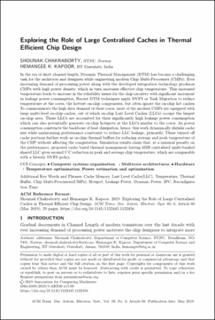| dc.contributor.author | Chakraborty, Shounak | |
| dc.contributor.author | Kapoor, Hemangee K | |
| dc.date.accessioned | 2020-05-18T07:45:25Z | |
| dc.date.available | 2020-05-18T07:45:25Z | |
| dc.date.created | 2020-02-06T14:44:04Z | |
| dc.date.issued | 2019 | |
| dc.identifier.citation | ACM Transactions on Design Automation of Electronic Systems. 2019, 24 (5), . | en_US |
| dc.identifier.issn | 1084-4309 | |
| dc.identifier.uri | https://hdl.handle.net/11250/2654711 | |
| dc.description.abstract | In the era of short channel length, Dynamic Thermal Management (DTM) has become a challenging task for the architects and designers engineering modern Chip Multi-Processors (CMPs). Ever-increasing demand of processing power along with the developed integration technology produces CMPs with high power density, which in turn increases effective chip temperature. This increased temperature leads to increase in the reliability issues for the chip-circuitry with significant increment in leakage power consumption. Recent DTM techniques apply DVFS or Task Migration to reduce temperature at the cores, the hottest on-chip components, but often ignore the on-chip hot caches. To commensurate the high data demand of these cores, most of the modern CMPs are equipped with large multi-level on-chip caches, out of which on-chip Last Level Caches (LLCs) occupy the largest on-chip area. These LLCs are accounted for their significantly high leakage power consumption that can also potentially generate on-chip hotspots at the LLCs similar to the cores. As power consumption constructs the backbone of heat dissipation, hence, this work dynamically shrinks cache size while maintaining performance constraint to reduce LLC leakage, primarily. These turned-off cache portions further work as on-chip thermal buffers for reducing average and peak temperature of the CMP without affecting the computation. Simulation results claim that, at a minimal penalty on the performance, proposed cache-based thermal management having 8MB centralised multi-banked shared LLC gives around 5°C reduction in peak and average chip temperature, which are comparable with a Greedy DVFS policy. | en_US |
| dc.language.iso | eng | en_US |
| dc.publisher | Association for Computing Machinery (ACM) | en_US |
| dc.title | Exploring the Role of Large Centralised Caches in Thermal Efficient Chip Design | en_US |
| dc.type | Peer reviewed | en_US |
| dc.type | Journal article | en_US |
| dc.description.version | acceptedVersion | en_US |
| dc.source.pagenumber | 28 | en_US |
| dc.source.volume | 24 | en_US |
| dc.source.journal | ACM Transactions on Design Automation of Electronic Systems | en_US |
| dc.source.issue | 5 | en_US |
| dc.identifier.doi | 10.1145/3339850 | |
| dc.identifier.cristin | 1791674 | |
| dc.description.localcode | © ACM, 2019. This is the author's version of the work. It is posted here by permission of ACM for your personal use. Not for redistribution. The definitive version was published here, http://dx.doi.org/10.1145/3339850 | en_US |
| cristin.ispublished | true | |
| cristin.fulltext | original | |
| cristin.fulltext | postprint | |
| cristin.qualitycode | 1 | |
